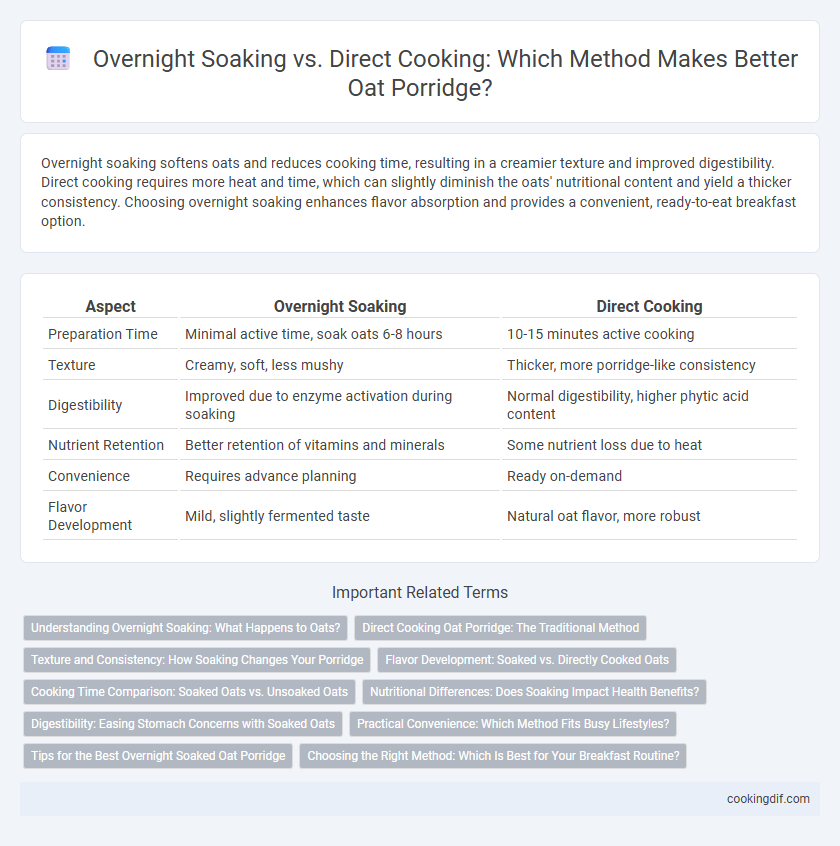Overnight soaking softens oats and reduces cooking time, resulting in a creamier texture and improved digestibility. Direct cooking requires more heat and time, which can slightly diminish the oats' nutritional content and yield a thicker consistency. Choosing overnight soaking enhances flavor absorption and provides a convenient, ready-to-eat breakfast option.
Table of Comparison
| Aspect | Overnight Soaking | Direct Cooking |
|---|---|---|
| Preparation Time | Minimal active time, soak oats 6-8 hours | 10-15 minutes active cooking |
| Texture | Creamy, soft, less mushy | Thicker, more porridge-like consistency |
| Digestibility | Improved due to enzyme activation during soaking | Normal digestibility, higher phytic acid content |
| Nutrient Retention | Better retention of vitamins and minerals | Some nutrient loss due to heat |
| Convenience | Requires advance planning | Ready on-demand |
| Flavor Development | Mild, slightly fermented taste | Natural oat flavor, more robust |
Understanding Overnight Soaking: What Happens to Oats?
Overnight soaking activates enzymes in oats, breaking down starches and reducing phytic acid, which enhances nutrient absorption and digestibility. This process softens the oats, leading to a creamier texture without prolonged cooking time. Soaked oats also develop a milder flavor profile compared to direct cooking, making them ideal for quick and nutritious porridge preparations.
Direct Cooking Oat Porridge: The Traditional Method
Direct cooking oat porridge involves boiling oats directly in water or milk, ensuring a creamy texture and fully gelatinized starches that enhance digestibility. This traditional method allows for immediate preparation, making it ideal for fresh, hot servings with customizable consistency by adjusting the cooking time. Using steel-cut or rolled oats in direct cooking maximizes flavor release and nutrient absorption, providing a hearty and satisfying breakfast.
Texture and Consistency: How Soaking Changes Your Porridge
Overnight soaking oats significantly softens their texture, resulting in a creamier and smoother porridge compared to direct cooking, which often yields a chewier, less uniform consistency. The soaking process allows oats to absorb moisture fully, reducing cooking time and promoting an even, tender mouthfeel. Direct cooking typically retains a firmer bite and more distinct oat grains, appealing to those who prefer a heartier porridge texture.
Flavor Development: Soaked vs. Directly Cooked Oats
Overnight soaking of oats enhances flavor development by allowing natural enzymes to break down starches and release a nuttier, richer taste compared to direct cooking. Soaked oats tend to have a smoother texture and deeper, more complex flavor profiles due to prolonged moisture absorption and gentle enzymatic activity. Directly cooked oats deliver a quicker, straightforward oatmeal experience but often lack the nuanced flavors achieved through overnight soaking.
Cooking Time Comparison: Soaked Oats vs. Unsoaked Oats
Overnight soaking oats significantly reduces cooking time by softening the grains and allowing water absorption, enabling porridge to be prepared in just a few minutes on the stovetop or even eaten cold. Unsoaked oats typically require longer cooking durations, often 10 to 15 minutes, to achieve a creamy texture and proper softness. This time difference translates to convenience and energy savings with soaked oats, making them ideal for quick, nutritious breakfasts.
Nutritional Differences: Does Soaking Impact Health Benefits?
Overnight soaking of oats initiates enzymatic activity that breaks down phytic acid, improving mineral absorption compared to direct cooking. Soaked oats retain more heat-sensitive vitamins like vitamin B and antioxidants, enhancing the overall nutritional profile of oat porridge. Direct cooking, while quicker, may reduce some nutrient availability due to higher cooking temperatures and shorter preparation times.
Digestibility: Easing Stomach Concerns with Soaked Oats
Overnight soaking of oats breaks down phytic acid and activates enzymes that enhance nutrient absorption, improving digestibility and reducing stomach discomfort. Direct cooking, while quicker, may leave some anti-nutrients intact, potentially causing bloating or indigestion for sensitive individuals. Soaked oats are recommended for those seeking a gentler option on digestion and improved nutrient bioavailability.
Practical Convenience: Which Method Fits Busy Lifestyles?
Overnight soaking for oat porridge significantly reduces morning preparation time by softening oats in advance, making it ideal for busy lifestyles with tight schedules. Direct cooking requires immediate attention and longer active cooking time, which may not suit individuals seeking quick, hands-off breakfast options. Choosing overnight soaking optimizes convenience and efficiency for those prioritizing ease and time management in their morning routine.
Tips for the Best Overnight Soaked Oat Porridge
Soaking oats overnight enhances their digestibility and reduces cooking time, making the porridge creamier and easier to digest. Use rolled oats rather than steel-cut for optimal texture, and soak them in milk or plant-based alternatives to deepen flavor and nutritional value. Adding a pinch of salt and stirring before refrigeration improves consistency and prevents clumping, ensuring the best overnight soaked oat porridge.
Choosing the Right Method: Which Is Best for Your Breakfast Routine?
Overnight soaking oats enhances digestibility and reduces cooking time by allowing grains to absorb water and soften naturally, making it ideal for busy mornings or those seeking a creamy texture without heat. Direct cooking produces a warm, comforting porridge with immediate nutrient availability and a richer flavor, perfect for traditional breakfast preparation. Choosing between these methods depends on your lifestyle priorities: convenience and texture versus warmth and speed.
Overnight soaking vs direct cooking for oat porridge Infographic

 cookingdif.com
cookingdif.com